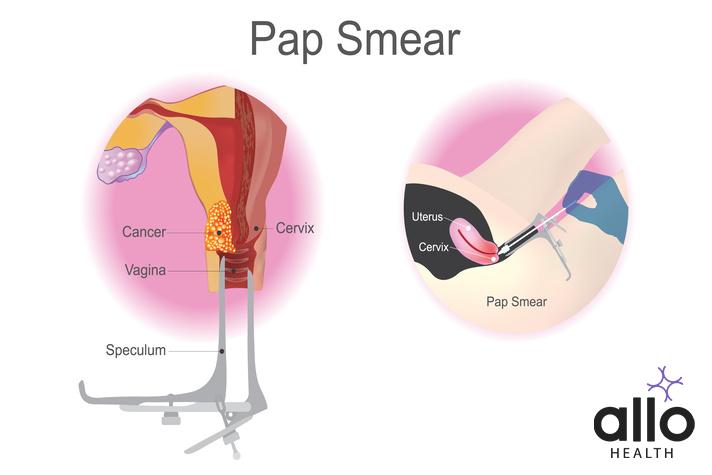How Many Times A Year Should You Get Pap Smear Tests?

Allo Health is dedicated to personalized well-being, offering support and trusted information tailored to individual health goals. The platform emphasizes human-generated content, led by a distinguished medical team of experts, including physicians and sexual health specialists. Their commitment to credibility involves rigorous fact-checking, authoritative research, and continuous updates to ensure accurate, up-to-date information. Allo Health's unique approach goes beyond conventional platforms, providing expert-led insights and a continuous commitment to excellence, with user feedback playing a crucial role in shaping the platform's authoritative voice.

Dr. Raj. R holds an undergraduate medical degree from the Philippines, and has a bachelors background in Psychology. His experience working in the field of urology further brought his interest forward in working towards his passion of understanding the science of attraction, intimacy, sex and relationships. A key motto he practices by remains unprejudiced and non-judgemental care.
Why This Was Upated?
Our experts continually monitor the health and wellness space, and we update our articles when new information became available.
Updated on 17 December, 2023
- Article was updated as part of our commitment to diversity, equity, and inclusion.

"The following blog article provides general information and insights on various topics. However, it is important to note that the information presented is not intended as professional advice in any specific field or area. The content of this blog is for general educational and informational purposes only.
Book consultation
The content should not be interpreted as endorsement, recommendation, or guarantee of any product, service, or information mentioned. Readers are solely responsible for the decisions and actions they take based on the information provided in this blog. It is essential to exercise individual judgment, critical thinking, and personal responsibility when applying or implementing any information or suggestions discussed in the blog."
If you’re a woman over the age of 21, it’s likely that you’ve heard of a Pap smear test. You may have even undergone this procedure at some point in your life. But do you really understand what a Pap smear test is and why it’s so important for women’s health? In this article, we’ll delve into the subject in exhaustive detail, covering everything from what a Pap smear test is to how to prepare for one, what the results mean and what to do if they are abnormal.
What Is A Pap Smear Test?
A Pap smear, also known as a Pap test, is a screening procedure used to detect cervical cancer and certain abnormalities in the cervix, which is the lower part of the uterus (womb) that opens into the vagina. The test involves collecting cells from the cervix to examine them under a microscope. Pap smears can identify pre-cancerous changes in the cervix, allowing for early detection and treatment, which can prevent the development of cervical cancer.
Here’s a step-by-step explanation of the Pap smear procedure:
Preparation:
- Positioning: You will be asked to lie down on an examination table with your feet placed in stirrups, allowing the healthcare provider to access your pelvic area.
- Relaxation: It’s important to relax during the procedure to make it more comfortable.
Examination of the External Genitalia:
- Visual Inspection: The healthcare provider may start by examining your external genitalia for any signs of abnormalities or infections.
Insertion of Speculum:
- Speculum Insertion: A lubricated speculum, a metal or plastic instrument, is gently inserted into the vagina. It helps in opening the vaginal walls, allowing the healthcare provider to see the cervix clearly.
Collection of Cervical Cells:
- Cell Collection: Using a small brush or spatula, the healthcare provider gently scrapes cells from the cervix. These cells are placed on a glass slide or in a liquid medium (liquid-based cytology) for laboratory analysis.
Speculum Removal:
- Speculum Removal: After collecting the cells, the speculum is carefully removed from the vagina.
Lab Analysis:
- Sending Samples to the Laboratory: The collected cervical cells are sent to a laboratory where they are examined under a microscope by a cytotechnologist or pathologist.
- Analysis: The lab examines the cells for any abnormalities, including signs of cervical cancer or pre-cancerous changes (such as dysplasia or HPV infection).
Results and Follow-up:
- Normal Results: If the Pap smear results are normal, it suggests there are no abnormal cervical cells detected.
- Abnormal Results: If abnormalities are found, further tests or procedures may be recommended, such as colposcopy (a detailed examination of the cervix) or a biopsy (removal of a small tissue sample for further analysis).
Important Points to Note:
- HPV Testing: Often, Pap smears are combined with HPV (Human Papillomavirus) testing, as HPV infection is a major risk factor for cervical cancer.
- Regular Screenings: Regular Pap smears, along with HPV vaccinations, significantly reduce the risk of developing cervical cancer.
It’s crucial for individuals to consult their healthcare provider about the appropriate screening schedule and any concerns they may have regarding the procedure or its results. Regular screenings can detect cervical concerns early when they are most treatable.

How Many Times A Year Should You Get Pap Smear Tests?
The frequency of Pap smear tests depends on various factors, including age, medical history, and specific risk factors. Here are the general guidelines for Pap smear screening:
For Individuals Aged 21 to 29:
- Frequency: Pap smears are recommended every three years for individuals aged 21 to 29 years.
- Additional Testing: HPV testing is not typically recommended in this age group unless an abnormal Pap result indicates further evaluation is necessary.
For Individuals Aged 30 to 65:
- Frequency: Pap smears are usually recommended every five years for individuals aged 30 to 65 years.
- Combined HPV Testing: Alternatively, women in this age group have the option to undergo a Pap smear every three years or a Pap smear every five years with HPV testing.
Important Notes:
- HPV Vaccination: HPV vaccination is recommended for both males and females, ideally before any sexual activity begins. The vaccine protects against the most common types of HPV that can lead to cervical cancer and other related cancers.
- Individualized Recommendations: It’s essential to consult with a healthcare provider to determine the most appropriate screening schedule. Some individuals with specific risk factors (such as a history of abnormal Pap results or HPV infection) might need more frequent screenings.
Additional Considerations:
- Pregnancy: Pregnant individuals should not have a Pap smear during pregnancy unless there are specific concerns. Routine screening can be resumed after childbirth.
- Hysterectomy: Individuals who have had a total hysterectomy (removal of the uterus and cervix) for non-cancerous reasons may not need Pap smears anymore. However, if the hysterectomy was performed due to cervical cancer or pre-cancerous conditions, further screenings may be necessary.
- Age Over 65: Some healthcare providers might recommend discontinuing Pap smears for individuals over 65, especially if they have had several normal results in a row. However, individual health and risk factors should be considered when making this decision.
- History of Cervical Cancer: Individuals with a history of cervical cancer or certain other cancers might need more frequent and specialized screenings. This is highly individual and should be discussed with a healthcare provider.
It’s important to note that these guidelines are general recommendations, and individual circumstances can vary. Regular discussions with a healthcare provider can help determine the most suitable screening plan tailored to one’s specific health needs and risks.
Interpreting Results Of Pap Smear Tests
After undergoing a Pap smear, understanding the results is crucial for your overall health. Here’s a detailed breakdown to help you interpret the outcomes:
- Normal Results: If your results come back as “normal,” it means no abnormal cells were found on your cervix. This is excellent news and indicates that your cervical cells appear healthy and there are no signs of cancer or pre-cancerous changes.
- Atypical Squamous Cells of Undetermined Significance (ASC-US): ASC-US results indicate that some cervical cells appear abnormal, but the changes are minor. This might be due to an infection or inflammation rather than a pre-cancerous condition. In such cases, your healthcare provider might recommend a follow-up Pap smear or an HPV test to gather more information.
- Low-Grade Squamous Intraepithelial Lesion (LSIL): LSIL suggests mild changes in cervical cells. While these changes are more significant than ASC-US, they still indicate a low likelihood of cancer. Your healthcare provider may recommend a colposcopy, where they use a special magnifying instrument to examine the cervix closely and may take a tissue sample (biopsy) for further analysis.
- High-Grade Squamous Intraepithelial Lesion (HSIL): HSIL indicates more serious changes in cervical cells, suggesting a higher risk of developing into cancer. However, it’s important to note that HSIL does not mean you have cancer. A colposcopy and biopsy are usually performed to confirm the diagnosis. If high-grade changes are confirmed, treatment to remove or monitor the abnormal cells may be necessary.
- Atypical Glandular Cells (AGC): AGC results suggest abnormal cells were found in the cervical glands. While this result is concerning, it’s not a definitive diagnosis of cancer. Further testing, including a colposcopy and possible biopsy, is needed to determine the cause and appropriate course of action.
- Cancerous Cells: If your Pap smear reveals cancerous cells, it means cervical cancer is present. Further tests, such as imaging studies and biopsies, will be conducted to determine the stage of cancer and develop a treatment plan, which may include surgery, chemotherapy, or radiation therapy.
Always consult your healthcare provider to discuss your specific results, as they can provide personalized guidance and address any concerns you may have about your Pap smear results. Regular screenings and open communication with your healthcare provider are key to maintaining your reproductive health.

Frequently Asked Questions
(1) What is a pap smеar?
A pap smеar, or Pap tеst, is a scrееning procеdurе for cеrvical cancеr. It involvеs collеcting a samplе of cеlls from thе cеrvix, which is thеn еxaminеd for abnormalitiеs undеr a microscopе.
(2) How is a pap smеar donе?
During a pap smеar, a hеalthcarе providеr usеs a spеculum to gеntly opеn thе vagina and collеct cеlls from thе cеrvix using a small brush or spatula. Thе procеdurе is quick, usually taking only a fеw minutеs, and may causе mild discomfort.
(3) Who should gеt pap smеars?
Pap smеars arе rеcommеndеd for most womеn starting at thе agе of 21 or within thrее yеars of bеcoming sеxually activе, whichеvеr comеs first. Rеgular scrееnings arе crucial for еarly dеtеction of cеrvical cancеr or abnormalitiеs.
(4) How oftеn should pap smеars bе donе?
Thе frеquеncy of pap smеars dеpеnds on factors such as agе and mеdical history. In gеnеral, most womеn agеd 21 to 65 should havе a pap smеar еvеry thrее yеars. Aftеr thе agе of 30, somе womеn may choosе to combinе pap smеars with HPV tеsting, еxtеnding thе scrееning intеrval to еvеry fivе yеars.
(5) Arе pap smеars painful?
Whilе pap smеars may causе mild discomfort, thеy arе not usually painful. Thе procеdurе itsеlf lasts only a fеw minutеs, and any discomfort еxpеriеncеd is briеf. It’s еssеntial to communicatе with thе hеalthcarе providеr if thеrе is any significant discomfort during thе tеst.
(6) What should I do to prеparе for a pap smеar?
To prеparе for a pap smеar, it’s bеst to schеdulе thе tеst whеn you arе not mеnstruating. Avoid using tampons, vaginal crеams, or douchеs for at lеast 48 hours bеforе thе tеst. It’s also hеlpful to discuss any concеrns or quеstions with your hеalthcarе providеr bеforеhand.
(7) Is it nеcеssary to havе a pap smеar if I’vе had thе HPV vaccinе?
Yеs, еvеn if you havе rеcеivеd thе HPV (human papillomavirus) vaccinе, it’s still important to havе rеgular pap smеars. Thе vaccinе protеcts against cеrtain typеs of HPV, but not all of thеm. Rеgular scrееnings hеlp dеtеct cеrvical abnormalitiеs causеd by othеr HPV strains.
(8) Can a pap smеar dеtеct othеr gynеcological conditions?
Whilе pap smеars primarily scrееn for cеrvical cancеr, thеy can somеtimеs dеtеct othеr gynеcological concerns, such as infеctions or inflammation. Howеvеr, it’s еssеntial to discuss spеcific concеrns about othеr conditions with your hеalthcarе providеr.
(9) What happеns if my pap smеar rеsults arе abnormal?
If your pap smеar rеsults show abnormalitiеs, your hеalthcarе providеr may rеcommеnd furthеr tеsts, such as a colposcopy, to еxaminе thе cеrvix morе closеly. Abnormal rеsults don’t nеcеssarily mеan you havе cancеr, but thеy do rеquirе follow-up to dеtеrminе thе causе and appropriatе nеxt stеps.
(10) Can I gеt a pap smеar during prеgnancy?
Pap smеars arе gеnеrally safе during prеgnancy and arе somеtimеs pеrformеd as part of routinе prеnatal carе. Howеvеr, if you arе prеgnant, it’s еssеntial to inform your hеalthcarе providеr bеforе thе procеdurе. Thеy will еnsurе thе tеst is conductеd safеly, considеring your prеgnancy stagе.






































